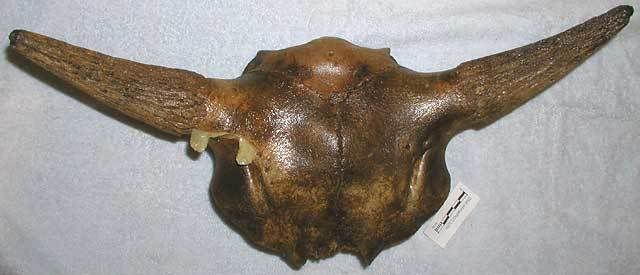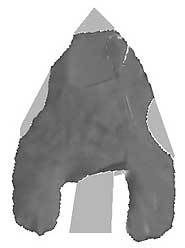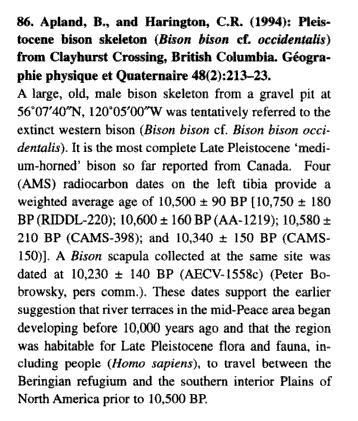|
|
Post by another specialist on May 23, 2008 19:46:54 GMT
Western Bison is an extinct species of bison that lived in North America during the Pleistocene. It was probably born of the Bison priscus. B. occidentalis was smaller and smaller horned than the steppe bison. Unlike any bison before it, its horns pointed upward, parallel to the plane of its face from nose to forehead, instead of pointing forward through that plane. Around 5,000 years ago, B. occidentalis was replaced by today's smaller Bison bison bison. It has been theorized that B. occidentalis declined in numbers because of competence with other grass eaters of the megafauna epoch. en.wikipedia.org/wiki/Bison_occidentalis |
|
|
|
Post by another specialist on May 23, 2008 19:54:55 GMT
|
|
|
|
Post by another specialist on May 23, 2008 20:00:52 GMT
Driving Home a Point Point of No Return Get the Point? Pointing Out the Obvious Point Taken A Pointed Comment A Data Package from the Arkansas River Leland Bement, Ernie Lundelius, Jr., and Richard Ketchum  These are all potential titles for an article describing the discovery of a Calf Creek style projectile point embedded in the forehead of a bison. The skull was discovered on a sand bar in the Arkansas River near Tulsa, Oklahoma. The collector, Kim Holt, assessing a skull fragment to see if it was worth carrying home, recognized the fragments of a projectile point protruding from this animal’s forehead. When brought to the attention of archaeologists at the Oklahoma Archeological Survey, University of Oklahoma, this incredible find set in motion a multi-disciplinary study incorporating archaeologists, geophysicists, and vertebrate Paleontologists. Inspection of the specimen by Survey archaeologists verified the authenticity of the find. A plan to document the specimen including radiocarbon dating of the bison skull, CT scan of the entire skull, and extensive photography was implemented immediately. The CT scan provided images of the blade of the projectile and documented the damage to the point and the skull. The point fractured upon entering the skull, driving a spall off the upper surface and removing the tip. This break preceded the splintering of the right barb, nicking of the lateral edges, and snapping of the stem/base. Fragments of the tip are cemented in the space between the upper surface of the projectile and the skull wall. The lack of damage to the back wall of the skull indicates the projectile point shattered as it was driven through the anterior wall. As of this writing, we believe the skull is from a 1 to 2 year old Bison occidentalis—a species that evolved into the modern Bison bison approximately 5000 years ago. The Calf Creek style of projectile point has been found at campsites yielding radiocarbon dates between 5200 and 4800 years ago, bridging the transition in bison species. Although researchers have debated whether this style of implement functioned as a spear point or that of a hafted knife, this specimen illustrates its effectiveness as a projectile point. That the animal was alive at the time of the attack is indicated by the displacement of the skull bone without subsequent fracture of the rear wall. Living bone is rather plastic and can flex to absorb the impact force and be displaced by the thickness of the point. The bone rebounded and clamped the point in place. This projectile point would not have killed the animal, but may have knocked it senseless, enabling the hunters time to inflict a mortal wound. We await the results of radiocarbon dating of the skull, but expect that it will be approximately 5000 years old. The skull has been donated to the Sam Noble Oklahoma Museum of Natural History and we look forward to seeing it on display soon.   CT scan of the skull and the Calf Creek point See QuickTime movies of the CT scan www.ou.edu/cas/archsur/Skull/movies.htmwww.ou.edu/cas/archsur/Skull/skull.htm |
|
|
|
Post by another specialist on Jun 15, 2008 10:49:08 GMT
 Annotated Bibliography of Quaternary Vertebrates of Northern North America By C.R. Harington |
|
|
|
Post by another specialist on Aug 11, 2008 16:45:31 GMT
 The Long Hunt By Ted Franklin Belue |
|
|
|
Post by another specialist on Aug 11, 2008 16:49:29 GMT
 Where the Mountains Meet the Prairies By Graham MacDonald |
|
|
|
Post by surroundx on Jan 26, 2016 13:38:05 GMT
Boeskorov, Gennady G. et al. (In Press, 2016). The Yukagir Bison: The exterior morphology of a complete frozen mummy of the extinct steppe bison, Bison priscus from the early Holocene of northern Yakutia, Russia. Quaternary International. doi:10.1016/j.quaint.2015.11.084 [ Abstract] |
|